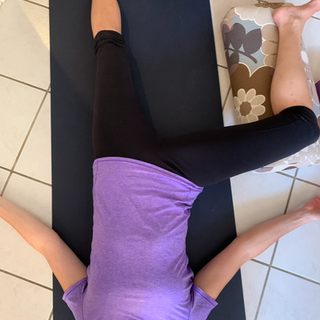
Tightness around the sacrum can radiate into hip pain.
Learn how to access the muscles around the lowest area of the spine, creating space and movement to find relief. Hip replacement patients should be particularly cautious attempting this type of rotation, see assistance below.
First step, checking in with your current mobility:
Lie down, face down, on a firm surface
Bend one leg, bringing that knee in line with the hip, out to the side (don’t hike the hip up)
Pressing into your hands with bent arms, rotate your chest and abdomen away from the bent leg
Extend the arm on the same side of the bent leg forward (this lengthens the side torso, work on lengthening that hip towards the extended foot)
Lengthen the inner thigh of the bent leg towards the inner knee, and that side’s buttock down to the floor - don't grip the buttock
Repeat on the other side
Finding the right height for you, height under the bent leg helps you to access the area a little deeper.
Items that can be used for height:
couch seat cushion or yoga bolster
yoga blocks or a few thick books
a bottom stair
If the previous position was enough, skip going deeper.
The height is to support the length of knee to the foot of the raised bent leg.
Assistance:
Even without height is too much - sometimes the starting position can be too difficult to get into... baby steps, we can still find relief. Lie down on your back, have the item you were going to use for height parallel with your upper thigh (more height is your friend here). Bend the knee and place the shin on the height, or against a wall or couch front at a height higher than the hip. Focus on extending the inner thigh towards to inner knee while keeping the opposite hip down on the floor by rotating the abdomen away from the bent leg.
If you've had a hip replacement - this type of rotation needs to be approached with caution. If you have fully healed from the replacement, have your doctor's approval, and don't suffer from pain when rotating the thigh bone outward - practice as mentioned above: lying on your back while supporting the outer shin, and in this case outer hip, as necessary.
Difficulty rotating the abdomen and chest - bend both arms, press the hands into the floor to get a better grip and therefore rotation. Once your deepest rotation is found, rest the forehead on the forearms.
How it helps:
Movement - to release a muscle, you need to access that muscle. By lengthening the groin, and allowing the outer hip to move into the body, you are lengthening the muscle beside the sacrum and accessing the hip as well.
Support as a means of release - when a muscle is strained, or tight, it cannot release. By providing support, you are allowing the area to open up gradually, to release into the support rather than to grip in order to hold the area in place.
Abdomen and chest rotation - by rotating away from the bent leg we are increasing the opening in the inner groin and allowing the hip to come further into the body. Ensure the bent leg hip doesn't start to hike up closer to its own shoulder, keep the side of the torso long, which also allows a lengthening of the lower back. The rotation is not the focus of the pose.
Creating a healthier body can be overwhelming...
Taking one moment at a time to relieve an ache or pain can make a goal more achievable, and worth your time.
Wishing you great health, Tanya

Tanya is a certified Iyengar Yoga teacher based out of Abbotsford, BC Canada. She has been teaching since 2015, strictly online since March 2020. Tanya volunteers her time as a board member for the BKS Iyengar Yoga Association Vancouver. Her greatest joy is being able to help discover movement.







Comments